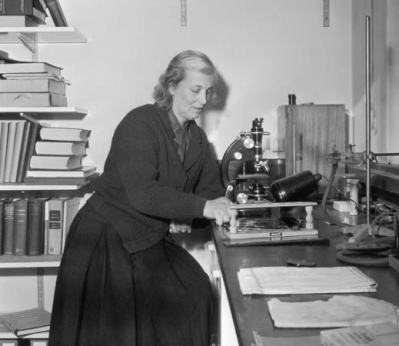In the latest of our series of articles, Linda Connor, an MSc student working with Advance Science and the Glycoscience Research Group, tells the story of the remarkable scientist Dorothy Crowfoot Hodgkin.

© Peter Lofts Photography, National Portrait Gallery, London
The story of Dorothy Crowfoot Hodgkin begins in Cairo, Egypt where she was born May 12, 1910. Her parents were John Winter Crowfoot, who worked in the Egyptian education service, later retiring to focus on archaeology, and Grace Mary Hood Crowfoot who was a botanist and illustrated a lot of the different flora found in Sudan.
Dorothy was interested in science at a young age and joined the boys in school with one other girl to study chemistry. She obtained her education in the UK, with her parents visiting during the summers. Dorothy also enjoyed studying pebbles she found in streams with her sister using a portable mineral analysis kit. At the age of 15, she was given a book called “Concerning the Nature of Things” and became attracted to the idea of studying the properties of molecules and atoms using x-rays.
“Broadly speaking, the discovery of x-rays has increased the keenness of our vision over ten thousand times and we can now “see” the individual atoms and molecules” – Sir William Henry Bragg in “Concerning the Nature of Things”.

Dorothy went to college in Oxford University, with the financial support of her aunt Dorothy Hood, to study chemistry. She also briefly studied archaeology in first year. After Oxford, she then proceeded to obtain her PhD in the University of Cambridge where she discovered how to use x-ray crystallography to figure out the structure of proteins.
This involved crystallising the substance being studied, then subjecting it to x-rays. The crystals caused the x-rays to diffract and by measuring the different angles of diffraction and employing a lot of complex calculations, Dorothy could figure out the structure of the molecule in question. As there were no computers at the time, Dorothy used small strips of paper (shown in the image above) called Beevers-Lipson strips as a computational aid.

She then returned to Oxford here she spent most of her remaining career, being responsible for teaching chemistry in the women’s colleges, one of her famous students being Margaret Thatcher. At the age of 27, she married Thomas Hodgkin and went on to have three children. She was diagnosed with rheumatoid arthritis at the age of 28 which meant she had to spend a lot of time in a wheelchair and made the delicate operations involved with her work difficult but this did not stop her from continuing her research.
Dorothy worked on the 3D structures of a number of biological molecules including cholesterol, penicillin, insulin and vitamin B12. She spent 35 years working on the structure of insulin being captivated by the complexity of it and the effects it has on the body. She began work on penicillin after being asked by Howard Florey to solve its structure once he had succeeded in isolating it. At this time, penicillin was the largest molecule that had been analysed using x-ray crystallography.
Dorothy Crowfoot Hodgkin was awarded the Nobel Prize for Chemistry in 1964 for her work on vitamin B12. The 3D image above shows how complex this molecule is compared to a simpler molecule like water. This Nobel Prize also acknowledged that her research had helped create a whole new field of research – structural biology. She was the third woman to receive the Nobel Prize in chemistry, following Marie Curie and Irene Joliot-Curie.

Image obtained from http://www.britannica.com/biography/Dorothy-Hodgkin
As well as being awarded a Nobel prize, she was also the second woman to receive the Order of Merit (the first was Florence Nightingale) and she is the only woman to receive the Copley Medal given by the Royal Society, London, for “outstanding achievements in research in any branch of science.”
Dorothy was one of the first people to go see the model of the double helix structure of DNA constructed by Watson and Crick in the University of Cambridge, a discovery also made possible by x-ray crystallography.
Humanitarian issues were one of Dorothy’s passions and she was particularly worried about the welfare of scientists and people living in nations considered adversaries by the US and UK like the Soviet Union and China. She was described as being soft-spoken, modest and was clearly a determined, hard-working lady. Dorothy suffered a stroke in 1994 and passed in her home in Warwickshire.
For more information on x-ray crystallography, check out the following animation
Sources:
“Dorothy Hodgkin“. Encyclopaedia Britannica.
“Dorothy Crowfoot Hodgkin” Chemical Heritage Foundation.
“Dorothy Crowfoot Hodgkin – Biographical”. Nobelprize.org.

